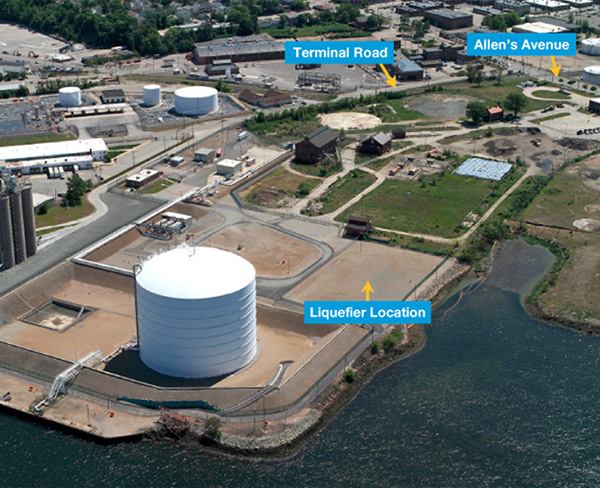National Grid Wants to Bring New Liquefied Natural Gas Project to Providence’s Waterfront
August 3, 2015

PROVIDENCE — Ten years after the federal government rejected a liquefied natural gas (LNG) shipping terminal on the city’s industrial waterfront, a new and different LNG project is being proposed for the same site.
National Grid, which now owns KeySpan LNG, the company that planned the gas terminal, wants to build an LNG production facility that will instead truck the concentrated gas to storage tanks in Cumberland and Exeter.
The site of the proposed facility, recognized by its 127-foot-tall fuel tank on the Providence River, is again drawing criticism. Project opponents claim the onsite production of LNG raises the risk of toxic chemical accidents and exposure in one of the most populated and impoverished parts of the state.
The added risks to low-income, predominately minority neighborhoods is a health hazard deemed “environmental racism” by the Environmental Justice League (EJL) of Rhode Island.
“It’s just going to put more toxins in the community,” Jesus Holguin, EJL’s youth leadership director, said about the natural gas project.
If approved, a new cooling plant would operate next to the 26-million-gallon storage tank and reside among several industrial facilities that emit or handle harmful materials. The LNG site is close to chemical distributor Univar, whose shipping facility stores food additives, and 1.4 million pounds of chlorine and chemicals used for hydraulic fracturing (fracking).
The waterfront industrial area includes a liquid asphalt plant that releases compounds linked to cancer and child development disorders. An oil terminal emits similar pollutants and others toxins linked to neurological and respiratory disorders. The Port of Providence also serves as a coal port, a fuel-oil depot, and a train depot for ethanol.
A 2014 report released by the Center for Effective Government ranked Rhode Island second in the nation for students attending schools near a facility that emits hazardous pollutants. In all, 67 percent of the state’s pre-K through 12th-grade students attend schools in high-risk zones that threaten chemical leaks, gas clouds, and explosions.
The Providence waterfront has the highest concentration of polluting businesses, according to the report.
EJL believes the nearby neighborhoods of South Providence and Washington Park are two of the most polluted in the state. Residents are routinely exposed to industrial emissions and pollution from traffic on Interstate 95.
“It’s already a toxic neighborhood because the highway is right there,” Holguin said.
On July 23, Holguin lead a “toxic tour” for EJL’s summer youth program, visiting the LNG facility and other industrial sites along the city’s waterfront. The teenage students toured brownfields, such as the former Gorham Manufacturing Co., where Alvarez High School was built. They discussed how the community is exposed to harm from industrial accidents and increased flooding.
They studied the impact of heavy industry mixed with strip clubs and major truck traffic. Holguin said this combination creates exploitative economic displacement, poverty, poor health conditions and segregation. All of which is deemed economic racism and eco-apartheid within Providence, according to EJL.
The social justice/environmental advocacy group is seeking support in its opposition to the new LNG project.
“There is already a high concentration of toxic and dangerous industrial facilities in Port of Providence, next to a residential low-income community of color with numerous schools, day care centers, and multiple hospitals. This is environmental racism,” according to the EJL website.
National Grid says the proposed LNG project isn’t a health or environmental threat.
“Our liquefied natural gas facility at Fields Point has been operating safely since 1974, and we have extensive measures in place to ensure its continued safe operation today and in the future,” National Grid spokeswoman Darlene Masse wrote in an e-mail to ecoRI News.
According to the trade group Center for Liquefied Natural Gas, LNG isn’t explosive and not stored under pressure. Gas liquefaction facilities comply with strict government regulations and industry standards for engineering, operations, maintenance and training, according to the group.
In July 2005 the Federal Energy and Regulatory Commission (FERC) denied the KeySpan LNG project because of safety and security concerns, in particular they cited the oversized tanker ships that required bridge closures to travel through Narragansett Bay.
Under the new proposal, National Grid has no plans to deliver LNG by ship. Natural gas will instead reach the plant through an existing pipeline. Once converted into LNG through extreme cooling, the concentrated gas would travel via special tanker trucks to other LNG tanks in the region. National Grid said the new facility will not increase truck traffic once operating.
The added volume of LNG stored around the state will eventually be re-gasified, through warming, to ease winter shortages and meet the region’s lopsided dependence on the fossil fuel. Currently, more than 95 percent of Rhode Island’s electricity is generated by natural gas.
The new facility isn’t expected to emit pollutants during its regular operations, according to National Grid. However, methane is released when excess LNG is flared, or burned off, when the cooling system is turned on and off.
The project requires permits from the state Coastal Resources Management Council and the Department of Environmental Management.
EJL and environmental groups such as Fossil Free RI plan to express their opposition to the project at an Aug. 13 public meeting hosted by National Grid in Providence.
Categories
Join the Discussion
View CommentsRecent Comments
Leave a Reply
Related Stories
Your support keeps our reporters on the environmental beat.
Reader support is at the core of our nonprofit news model. Together, we can keep the environment in the headlines.
We use cookies to improve your experience and deliver personalized content. View Cookie Settings




Opposed!